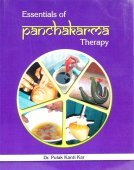Parinaha, Pariṇāha, Parīṇāha: 14 definitions
Introduction:
Parinaha means something in Hinduism, Sanskrit, Buddhism, Pali, Jainism, Prakrit. If you want to know the exact meaning, history, etymology or English translation of this term then check out the descriptions on this page. Add your comment or reference to a book if you want to contribute to this summary article.
In Hinduism
Jyotisha (astronomy and astrology)
Source: Wikibooks (hi): Sanskrit Technical TermsPariṇāha (परिणाह).—Periphery, circumference. Note: Pariṇāha is a Sanskrit technical term used in ancient Indian sciences such as Astronomy, Mathematics and Geometry.

Jyotisha (ज्योतिष, jyotiṣa or jyotish) refers to ‘astronomy’ or “Vedic astrology” and represents the fifth of the six Vedangas (additional sciences to be studied along with the Vedas). Jyotisha concerns itself with the study and prediction of the movements of celestial bodies, in order to calculate the auspicious time for rituals and ceremonies.
Languages of India and abroad
Pali-English dictionary
Source: BuddhaSasana: Concise Pali-English Dictionarypariṇāha : (m.) girth; dimensions; circumference.
Source: Sutta: The Pali Text Society's Pali-English DictionaryPariṇāha, (fr. pari+nah) compass, circumference, breadth, extent, girth S. II, 206 (of the moon)=A. V, 19; J. III, 192, 277, 370; V, 299; Pug. 53; Miln. 282, 311; SnA 382 (āroha+). (Page 426)

Pali is the language of the Tipiṭaka, which is the sacred canon of Theravāda Buddhism and contains much of the Buddha’s speech. Closeley related to Sanskrit, both languages are used interchangeably between religions.
Sanskrit dictionary
Source: DDSA: The practical Sanskrit-English dictionaryPariṇāha (परिणाह) or Parīṇāha (परीणाह).—
1) Circumference, compass, expanse, extent, breadth, width; स्तनयुगपरिणाहाच्छादिना वल्कलेन (stanayugapariṇāhācchādinā valkalena) Ś.1.19; स्तनपरिणाहविलासवैजयन्ती (stanapariṇāhavilāsavaijayantī) Mālatīmādhava (Bombay) 3.15 'large or expansive breasts'; ककुदे वृषस्य कृतबाहुमकृशपरिणाहशालिनि (kakude vṛṣasya kṛtabāhumakṛśapariṇāhaśālini) Kirātārjunīya 12.2; Mṛcchakaṭika 3.9; Ratnāvalī 2.13; Mv.7.24; नल्वमात्र- परीणाहो घनच्छायो वनस्पतिः (nalvamātra- parīṇāho ghanacchāyo vanaspatiḥ) Mahābhārata (Bombay) 12.154.7.
2) Periphery or circumference of a circle.
Derivable forms: pariṇāhaḥ (परिणाहः), parīṇāhaḥ (परीणाहः).
--- OR ---
Parīṇāha (परीणाह).—
1) = परिणाह (pariṇāha). नल्वमात्रपरीणाहो घनच्छायो वनस्पतिः (nalvamātraparīṇāho ghanacchāyo vanaspatiḥ) Mahābhārata (Bombay) 12.154.7.
2) A piece of common land encircling a village.
3) An epithet of Śiva.
Derivable forms: parīṇāhaḥ (परीणाहः).
Source: Cologne Digital Sanskrit Dictionaries: Shabda-Sagara Sanskrit-English DictionaryPariṇāha (परिणाह).—m.
(-haḥ) Width, breadth. 2. Circumference of a circle. E. pari extension, nah to bind, aff. ghañ vā dīrghaḥ .
Source: Cologne Digital Sanskrit Dictionaries: Benfey Sanskrit-English DictionaryPariṇāha (परिणाह).—parīṇāha, i. e. pari-nah + a, m. 1. Circumference, Mahābhārata 6, 276. 2. Width, [Śākuntala, (ed. Böhtlingk.)] [distich] 18. 3. Breadth, [Yājñavalkya, (ed. Stenzler.)] 2, 167.
Pariṇāha can also be spelled as Parīṇāha (परीणाह).
--- OR ---
Parīṇāha (परीणाह).—parītāpa parītāpa, parītoṣa parītoṣa, parīdāha parīdāha, parīdhāna parīdhāna, parī- pāka parīpāka, see pariṇaº pariṇāha, etc., with i.
Source: Cologne Digital Sanskrit Dictionaries: Cappeller Sanskrit-English DictionaryPariṇāha (परिणाह).—[masculine] compass, circumference, extent, width.
--- OR ---
Parīṇāha (परीणाह).—[masculine] = pariṇāma & ṇāha.
Source: Cologne Digital Sanskrit Dictionaries: Monier-Williams Sanskrit-English Dictionary1) Pariṇāha (परिणाह):—[=pari-ṇāha] [from pari-ṇah] m. compass, circumference, extent, width, breadth, circumference of a circle, periphery, [Mahābhārata; Kāvya literature; Sūryasiddhānta; Suśruta]
2) [v.s. ...] Name of Śiva, [cf. Lexicographers, esp. such as amarasiṃha, halāyudha, hemacandra, etc.] (cf. parī-ṇāha)
3) Parīṇāha (परीणाह):—[=parī-ṇāha] [from parī] m. (√nah) circumference, width, [Mahābhārata; Rāmāyaṇa; Suśruta]
4) [v.s. ...] a piece of common land encircling a village, [Yājñavalkya]
5) [v.s. ...] Name of Śiva, [cf. Lexicographers, esp. such as amarasiṃha, halāyudha, hemacandra, etc.] (cf. pari-ṇ).
Source: Cologne Digital Sanskrit Dictionaries: Yates Sanskrit-English DictionaryPariṇāha (परिणाह):—[pari-ṇāha] (haḥ) 1. m. Width, breadth.
Source: DDSA: Paia-sadda-mahannavo; a comprehensive Prakrit Hindi dictionary (S)Pariṇāha (परिणाह) in the Sanskrit language is related to the Prakrit word: Pariṇāha.
[Sanskrit to German]
Sanskrit, also spelled संस्कृतम् (saṃskṛtam), is an ancient language of India commonly seen as the grandmother of the Indo-European language family (even English!). Closely allied with Prakrit and Pali, Sanskrit is more exhaustive in both grammar and terms and has the most extensive collection of literature in the world, greatly surpassing its sister-languages Greek and Latin.
Prakrit-English dictionary
Source: DDSA: Paia-sadda-mahannavo; a comprehensive Prakrit Hindi dictionaryPariṇāha (परिणाह) in the Prakrit language is related to the Sanskrit word: Pariṇāha.
Prakrit is an ancient language closely associated with both Pali and Sanskrit. Jain literature is often composed in this language or sub-dialects, such as the Agamas and their commentaries which are written in Ardhamagadhi and Maharashtri Prakrit. The earliest extant texts can be dated to as early as the 4th century BCE although core portions might be older.
Kannada-English dictionary
Source: Alar: Kannada-English corpusPariṇāha (ಪರಿಣಾಹ):—
1) [noun] the space, amount or degree to which a thing extends; length; breadth.
2) [noun] an extended space; vast area.
3) [noun] the line bounding a circle, a rounded surface; circumference.
Kannada is a Dravidian language (as opposed to the Indo-European language family) mainly spoken in the southwestern region of India.
See also (Relevant definitions)
Starts with: Parinahana, Parinahavant, Parinahavat.
Ends with: Bhaparinaha, Samaparinaha, Vrittaparinaha.
Full-text: Parinahin, Vrittaparinaha, Aroha, Parinahya, Parinahavant, Anaha, Samaparinaha, Bhaparinaha, Parinama, Gupti.
Relevant text
Search found 5 books and stories containing Parinaha, Pariṇāha, Parīṇāha, Pari-naha, Pari-ṇāha, Parī-ṇāha; (plurals include: Parinahas, Pariṇāhas, Parīṇāhas, nahas, ṇāhas). You can also click to the full overview containing English textual excerpts. Below are direct links for the most relevant articles:
Matangalila and Hastyayurveda (study) (by Chandrima Das)
Measurement and Age of the Elephants < [Chapter 3]
The Agni Purana (by N. Gangadharan)
Kautilya Arthashastra (by R. Shamasastry)
Chapter 30 - The Superintendent of Horses < [Book 2 - The duties of Government Superintendents]
Apadana commentary (Atthakatha) (by U Lu Pe Win)
Commentary on Biography of the thera Kāḷudāyī < [Chapter 4 - Kuṇḍadhānavagga (section on Kuṇḍadhāna)]
The Mahavastu (great story) (by J. J. Jones)
Chapter II - Asita and the young Gotama < [Volume II]
Related products
